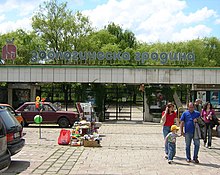| This article needs to be updated. Please help update this article to reflect recent events or newly available information. (August 2015) |
| Sofia Zoo | |
|---|---|
 The eastern entrance The eastern entrance | |
| 42°39′29″N 23°19′55″E / 42.65806°N 23.33194°E / 42.65806; 23.33194 | |
| Date opened | 1888 |
| Location | Sofia, Bulgaria |
| Land area | 36 ha (89 acres) |
| No. of animals | 2,460 |
| No. of species | 312 |
| Annual visitors | 800,000 |
| Website | www |


Sofia Zoo in Sofia, the capital of Bulgaria, was founded by royal decree on 1 May 1888, and is the oldest and largest zoological garden in Southeast Europe. It covers 36 hectares (89 acres) and, in March 2006, housed 4,850 animals representing 840 species.
History
Initially, the zoo was located in the park of the former royal palace, with the primary attraction being a Eurasian black vulture caught in Bulgaria and exhibited in a cage in the garden. Later, pheasants and deer were added to the collection, but since the exhibits and facilities of the time proved inadequate to accommodate a pair of brown bears, Tsar Ferdinand of Bulgaria ordered a grant of land to be awarded to Sofia Zoo on the grounds of the former botanical garden, then in the outskirts of the city.
Sofia Zoo's exhibition of animals constantly increased, with both local and foreign species being added, most notably a pair of lions in 1892, which were housed in a former stable and a lion cub was born the same year.
Between 1893 and 1895, new cages and buildings were constructed to accommodate the ever-increasing collection of birds and mammals, including a solid three-room stone building in the back of the terrain designed to be inhabited by bears (1894), a pool where a few pink-backed pelicans lived, a building to accommodate pheasants and another one for eagles (1895).
Sofia Zoo moved from its original (and smaller) location in the centre of the city to a new 36-hectare (89-acre) site about 4.5 kilometres (2.8 mi) south of Sofia in 1982.
In April 2023, it was announced that Sofia Zoo had become a member of the European Association of Zoos and Aquaria (EAZA). Due to the zoo's entry into EAZA, they now "will gain new quotas for obtaining animals, new opportunities for exchanging animals with other zoos, access to foreign experience, participation in international programs for conservation and breeding of over 400 rare and endangered species, the most modern training and professional development for zoo specialists, and access to an online platform for sharing knowledge and experience."
Exhibits
- Grazing animals
The zoo has some 80 individuals representing 20 grazing species, including white rhinos, hippopotamus, elephant, zebras, red deer, ibex, wild boar, dromedary camels, and American bison.
- Primates
Primates are housed in two pavilions. The zoo has 93 individuals representing 19 species, including ring-tailed lemurs, yellow baboons, common marmoset, and macaques.
- Predators
The predator sector houses big cats, bears and small predators, including lions, tigers, leopards, pumas and brown bears.
- Penguins
In January 2011 the zoo received eight Humboldt penguins on loan from Germany. The penguins were on loan for about 18 months. Afterward they were returned, with any offspring staying at the zoo.

- Birds
The zoo has some 1,400 individual birds representing 192 species. Waterbirds are housed in a 1.5-hectare (3.7-acre) lake, and Imperial eagles, Griffon vultures, Egyptian vultures and buzzards in a large walk-through aviary. Other species of birds at the zoo include ostriches, Silver pheasants, peacocks, flamingos, blue-and-yellow macaws, owls, cockatoos and cockatiels.
Other facilities
The zoo's veterinary clinic includes a separate entrance and is accessible to the public without entry to the zoo.
Incidents
In 2009, the central heating at the zoo was shut down because the gas supply into the country was stopped by Russia due to a pricing dispute. About a third of the 1,300 animals at the zoo were vulnerable to the resulting cold and employees had to find portable electric and oil heaters to heat their enclosures.
Gallery
Notes
- ^ "Zoo". zoosofia.eu. Zoo Sophia. Retrieved 23 April 2011.
- ^ The Zoo in numbers zoosofia.eu
- ^ "Sofia Zoo gives shelter to 8 new penguins, attracting more visitors". focus-fen.net. FOCUS Information Agency. 6 March 2011. Retrieved 14 April 2011.
- ^ "Zoo". zoosofia.eu. Zoo Sophia. Retrieved 23 April 2011.
- "Sofia Zoo Joins European Association of Zoos and Aquaria". www.bta.bg. Archived from the original on 30 November 2023. Retrieved 30 November 2023.
- SOLAKOVA, DIMITRINA (3 May 2023). "Sofia Zoo's Membership in European Association of Zoos and Aquaria Is Historical Event - Sofia Zoo Director". www.bta.bg. Archived from the original on 15 May 2023. Retrieved 30 November 2023.
- "Grazing Sector". zoosofia.eu. Zoo Sophia. Retrieved 23 April 2011.
- "Primates Sector". zoosofia.eu. Zoo Sophia. Retrieved 23 April 2011.
- "Predators Sector". zoosofia.eu. Zoo Sophia. Retrieved 23 April 2011.
- "Humboldt Penguins Feel at Home in Sofia's Zoo". novinite.com. Novinite Ltd. 5 March 2011. Retrieved 24 April 2011.
- "Bird Sector". zoosofia.eu. Zoo Sophia. Retrieved 23 April 2011.
- "Animals in Sofia Zoo Severely Affected by Russian Gas Cut". novinite.com. Novinite Ltd. 9 January 2009. Retrieved 24 April 2011.
External links
![]() Media related to Sofia Zoo at Wikimedia Commons
Media related to Sofia Zoo at Wikimedia Commons
| Zoos of Bulgaria | |
|---|---|
| Zoos | |
| Aquariums | |
















